|
Intervention/Decoration
Various sites, Frome, Somerset
10th May - 21st June 2008
From the 10th of May to 21st of June Frome was host to
Intervention/Decoration an ambitious contemporary art exhibition that
responded to the local context of the town and played with the themes
embedded in the exhibition title.
The title suggested both a light hearted aesthetic with the art
historical connotations of decoration being a frivolous, fashion and
very much craft orientated arena; combined with the social and political
connotations of intervention that we have come to expect from rigorous
public and site based work. These seemingly opposing positions were
united through the exhibited artworks, where the decorative is used as
both an aesthetic and a means of interrupting the everyday life of the
town, prompting a reassessment and reconsideration of the surrounding
site, and initiating discussion on the nature of the artworks
positioning within the public domain.
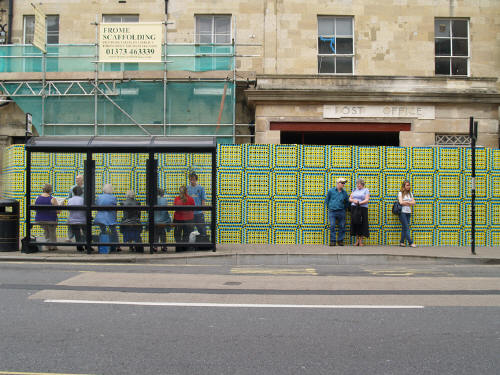
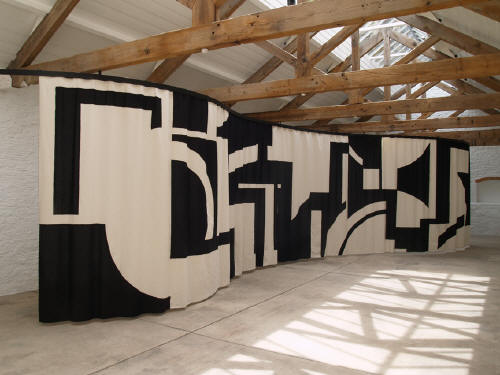
The majority of artists who participated in Intervention/Decoration used
decorative means as a central part of their practice, playing with the
high art divide. The ability for pattern to be both a signifier of
various histories and to produce a critical dialogue with its placement
in the public domain was most evident in the work of Jim Isermann. For
Intervention/Decoration Isermann developed a poster of vibrant pattern
taken from traditional weaving designs produced in Frome in the 1950s.
Pasted across building hoardings and boarded up windows, the posters
infused patches of colour throughout the townscape, enlivening the area
and bringing into contemporary life a motif from the town’s history;
transforming the present and referencing the past. The use of the
vibrant motif to cover-up disused buildings and broken windows further
carries with it a utopian vision of the potential for bold colour and
careful design to regenerate the public arena.
The intervention of the decorative within the public domain was further
seen in the work of Eva Berendes. In the interior of a disused Silk Mill
building Berendes installed a snaking curtain of patterned fabric. The
geometric design drew on the use of abstract motifs throughout the 20th
century, from traditional hand crafted textiles to the Bauhaus
aesthetic. Installed in the Silk Mill the curtain rested on the boundary
between domestic decoration and architectural intervention. The large
dimensions of the fabric cut through the Mill space, dominating the
audience and manipulating their experience of the building whilst
simultaneously surrounding them in a decorative design. Berendes played
with the constructed critical divide between intervention and simple
decoration.

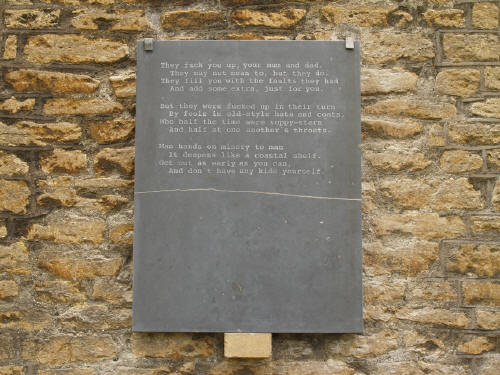
Alongside the decorative, text was employed as both a visual
interruption in the town and a subtle mediation on the pervasive and
powerful use of language in the public domain. Bright orange letters
were written across the high building of the Old Silk Mill easily
visible from the town centre spelling out ‘AT A DISTANCE TO THE
FOREGROUND’. The painted text was the work of American artist Lawrence
Weiner. The lettering played with its own positioning and simultaneously
suggested the subtle hierarchies of public space with the dominant
position of the Mill visible throughout the local area.
Text further took a central role in the work of Cornelia Parker. For
Intervention/Decoration, Parker responded to Frome’s strong history of
non-conformist worship and the recent death of her parents to produce a
challenging ornamental memorial. Parker appropriated Philip Larkin’s
most infamous poem This Be The Verse and fused its confrontational but
incisive analysis of British society with traditional craftsmanship to
produce a ledger stone that she describes as, a ‘non-conformist
epitaph’. Situated opposite a Wesleyan Church and graveyard the
positioning of the work intensified its mediation on remembrance and the
tradition of commemoration. Parker’s use of the provocative yet highly
poetic language of Larkin alluded to the ability of text to trigger
cultural metaphors and personal associations, relocating aspects of the
everyday into compelling and extraordinary sentiments.
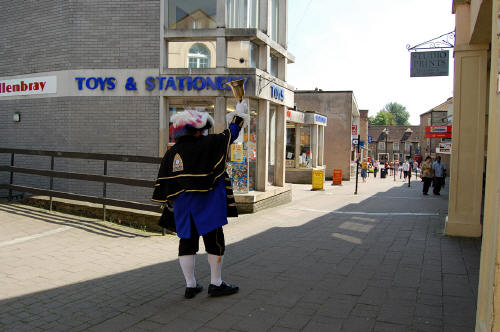
In another facet of text-based work the artist Ruth Ewan has enlisted
the town crier to make a series of proclamations. Short, abstract and
somehow prophetic, the cries marked a rupture in the momentum of the
day, initiating contemplation of the immediate space and infusing new
narratives within the existing dialogues of the town. Crying out the
phrase “unrecorded future tell us what broods there” the town crier
commanded attention as the words hung in the silenced air before moving
with the surrounding pubic back into the momentum of the day.
Subsequently written in poster format and displayed in the Black Swan, a
former tavern, the text called by the town crier formed an evolving
script throughout the duration of the exhibition. Ruth Ewan’s practice
explores the use of language within the public domain investigating the
circulation of radical ideas within popular culture. Taking texts from
the writings of Gustav Spiller a leading figure in the transatlantic
pacifist, humanitarian and ethical movements in Britain producing the
publication, Poems of Human Service (The Utopia Press, London 1927) Ewan
used the traditional performance of the town crier to infuse subtle
mediations on humanitarian ideals within the daily fabric of Frome,
temporarily re-activating historical aspirations towards a more
egalitarian society.
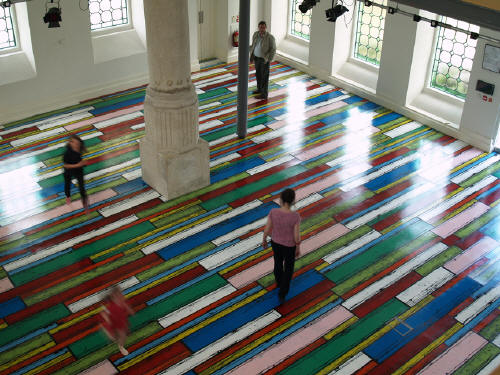

Further works in the
exhibition included Michael Dean’s intricate sculpture garden and
Richard Wood’s vibrant installation of coloured flooring in a former
non-conformist Chapel.
The diversity of artworks within the exhibition were united through
their shared contemplations on the definition and use of public space,
and the role of intervention and decoration within the public and
artistic domain. Unexpected instances of pattern and text intervened
with the everyday structure of the town, producing discourses upon the
various histories and narratives of each site.
Intervention/Decoration was a
highly successful exhibition that positioned contemporary art in an
unexpected rural location and effectively engaged with the locality
producing an intriguing and refreshing aesthetic whilst simultaneously
igniting discussion on the use of decorative and text based work as a
rigorous from of contemporary art practice.
Laura Mansfield 25/7/08
Intervention/Decoration was the inaugural project by Foreground, a new
contemporary art commissioning organisation based in Frome, Somerset.
www.foregroundprojects.org.uk
|







